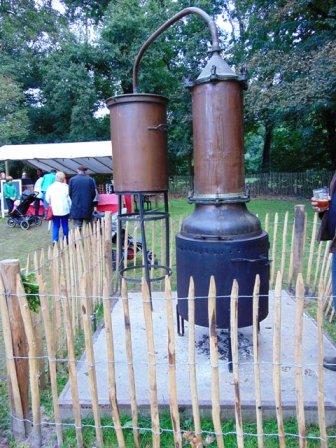To achieve a higher alcohol content, we have to distill.
If you have distilled the mash two times you get a tasteless strong alcohol of around 80-85 volume% which is excellent as a base for liqueurs and bitters.
 The mixture is heated and all vapors are collected and condensed in a (possibly spiral-shaped, which is longer) air- or liquid-cooled pipe (the vapor cools and forms drops).
The mixture is heated and all vapors are collected and condensed in a (possibly spiral-shaped, which is longer) air- or liquid-cooled pipe (the vapor cools and forms drops).
Make sure that the cooling water in the cooling column flows against the direction of flow of the alcohol vapors. This will always maximize the temperature difference between cooling water and alcohol vapor.
During the war illegal distillers used a large brass scale over an open boiler on a low fire and caught and condened the vapors. The scale was cooled with wet cloths. The from the obliquely hung scale dripping distillate was collected. When controlled there was no distillation equipment found. But there was also a lot of vapor, and thus also alcohol lost.
Although the boiling point of ethanol is 78.31⁰C, the flash point is at 12⁰C. The explosion limit is between 3.4 and 19% by volume in air. So make sure to provide adequate ventilation...!!
The basic product defines the taste: vodka (potatoes), gin (from sprouted grain made wort) or brandy (cheap white wine), rum (sugar molasses), calvados (apple), sake (rice).
Single malt whiskeys include whiskey (blends) of one distillery.
Blended malt is made from malt whiskeys from different distilleries.
For good stuff you must distil repeatedly: twice for fruit, sometimes three times (for cereals).
‘Effective remedy for hangover : take the juice of half a bottle of whiskey...’(Eddie Condon)
‘The best way to cure a hangover is to drink no alcohol the previous evening.’(Cathy Hopkins)
Freeze-distilling
Fractional freezing is another method to pimp the alcohol content of your brew.
Not only the boiling point, but also the freeze- or thaw point (-114 degrees) is different to that of water.
You can increase the alcohol content of a mixture by freezing it (partially). The not frozen part, or the part that through a sieve first thaws, contains more alcohol. The ice crystals remain in the sieve or filter. You can also siphon the liquid part.
The method is used in Apple Jack (heavy apple cider) and Eisbock (strong beer). A little bit similar to ice wine: before fermentation frozen water is removed, so you get not more alcohol, but more sugar. This work was done in the winter, by putting the stuff outside and skim ice regularly off. So this is also a way to distill without having prohibited equipment in house.
Alcohol is used to disinfect (material) (70% + up!), as fuel (+ 50%), or to conserve vegetables.
You can determine the proportion of alcohol in a measured or weighed distillate which contains water: heat it moderate (possibly ’au bain Marie’(in a water bath)). Certainly not boil it. The alcohol evaporates. The proportion of water remains. So you can control the volume ratio. (water weighs 1kg / l, alcohol 0.8).
'Household tip: with alcohol can you keep everything except secrets.’(Oscar Wilde)
